Development of a Simplified One-Dimensional Model of Humidity in the Cabin of a Passenger Aircraft Based on an Experiment
Abstract
1. Introduction
2. Materials and Methods
3. Results and Discussion
4. Modeling Humidity in the Cabin of a Passenger Plane
5. Conclusions
Author Contributions
Funding
Institutional Review Board Statement
Informed Consent Statement
Data Availability Statement
Conflicts of Interest
Nomenclature
| m | number of passengers in the cabin of a passenger plane (person) |
| n | air change rate m (h−1) |
| qg | internal moisture generated by an aircraft passenger (g/(h × person)) |
| Qg | the internal sum of moisture emitted by all passengers in an airliner (g/h) |
| Qn | moisture added or removed by mechanical ventilation (g/h) |
| Tavg | average temperature in the cabin of a passenger plane (°C) |
| t | time (min) or (h) |
| V | passenger aircraft cabin volume (m3) |
| Greek symbols | |
| ϕavg | average relative humidity in the cabin of a passenger plane (%) |
| ωinside | internal absolute humidity in the cabin of a passenger aircraft determined using Equation (5) |
| ωsupply | absolute humidity of the air supplied from the supply ventilation (g/m3) |
| ωt=0 | initial value of absolute humidity in the cabin of a passenger aircraft at the moment of take-off (g/m3) |
References
- ASHRAE Standard 55, Rev. 2017; Thermal Environmental Conditions for Human Occupancy. ASHRAE Standard: Peachtree Corners, GA, USA, 2017.
- Dumała, S.M.; Guz, Ł.; Badora, A. Indoor Air Quality in Schools Located in Poland, Lublin Province. J. Ecol. Eng. 2024, 25, 17–26. [Google Scholar] [CrossRef] [PubMed]
- Yang, Z.; Gao, W.; Yang, D.; Hu, X.; Xu, T. Impact of Air Velocity on Mold Growth in High Temperature and Humidity Condi-tions: An Experimental Approach. Buildings 2024, 14, 2145. [Google Scholar] [CrossRef]
- Shevchenko, O.; Sulzer, M.; Christen, A.; Matzarakis, A. Coupling Indoor and Outdoor Heat Stress During the Hot Summer of 2022: A Case Study of Freiburg, Germany. Atmosphere 2025, 16, 167. [Google Scholar] [CrossRef]
- Luque, J.M.M.; Jiménez, J.L.S.; Ruiz de Adana, M. Spatial and Temporal Distribution of CO2 and Thermal Comfort Conditions in a Day Care Center. Atmosphere 2024, 15, 1500. [Google Scholar] [CrossRef]
- Priyadarshani, S.; Rao, R.R.; Mani, M.; Maskell, D. Examining Occupant-Comfort Responses to Indoor Humidity Ratio in Con-ventional and Vernacular Dwellings: A Rural Indian Case Study. Energies 2023, 16, 6843. [Google Scholar] [CrossRef]
- Wang, S.; Cao, X.; Miao, D.; Pang, L.; Li, J. A Review of In-Flight Thermal Comfort and Air Quality Status in Civil Aircraft Cabin Environments. Buildings 2024, 14, 2001. [Google Scholar] [CrossRef]
- Sterling, E.M.; Arundel, A.; Sterling, T.D. Criteria for Human Exposure to Humidity in Occupied Buildings. Ashrae Trans. 1985, 91, 611–622. [Google Scholar]
- Yang, W.; Elankumaran, S.; Marr, L.C. Relationship between Humidity and Influenza A Viability in Droplets and Implications for Influenza’s Seasonality. PLoS ONE 2012, 7, e46789. [Google Scholar] [CrossRef] [PubMed]
- Giaconia, C.; Orioli, A.; Di Gangi, A. Air quality and relative humidity in commercial aircrafts: An experimental investigation on short-haul domestic flights. Build. Environ. 2013, 67, 69–81. [Google Scholar] [CrossRef]
- Yu, N.; Zhang, Y.; Zhang, M.; Li, H. Thermal Condition and Air Quality Investigation in Commercial Airliner Cabins. Sustainability 2021, 13, 7047. [Google Scholar] [CrossRef]
- Gładyszewska-Fiedoruk, K. Indoor Air Quality in the Cabin of an Airliner. J. Air Transp. Manag. 2012, 20, 28–30. [Google Scholar] [CrossRef]
- Haghighat, F.; Allard, F.; Megri, A.C.; Blondeau, P.; Shimotakahara, R. Masurement of thermal comfort and indoor air quality aboard 43 flights on commercial airlines. Indoor Built Environ. 1999, 8, 58–66. [Google Scholar] [CrossRef]
- da Silva, M.C.G.; Broday, E.E.; Ruivo, C.R. Indoor Climate Quality Assessment in civil aircraft cabins: A field study. Therm. Sci. Eng. Prog. 2023, 37, 101581. [Google Scholar] [CrossRef]
- Chen, Q.; Jones, B.W.; Loo, S.M.; Nazaroff, W.W.; Overfelt, R.A.; Weisel, C.P.; Weschler, C.J. Report to the FAA on the Airliner Cabin Environment. Report No. RITE-ACERCoE-2010-1. National Air Transportation Center of Excellence for Research in the Intermodal Transport Environment (RITE)—Airliner Cabin Environmental Research (ACER) Program. 2010. Available online: https://www.faa.gov/sites/faa.gov/files/data_research/research/med_humanfacs/cer/AirlinerCabinEnvironmentReport.pdf (accessed on 3 May 2023).
- Lee, S.; Poon, C.; Li, X.; Luk, F. Indoor air quality investigation on commercial aircraft. Indoor Air 1999, 9, 180–187. [Google Scholar] [CrossRef] [PubMed]
- Norrefeldt, V.; Mayer, F.; Herbig, B.; Ströhlein, R.; Wargocki, P.; Lei, F. Effect of Increased Cabin Recirculation Airflow Fraction on Relative Humidity, CO2 and TVOC. Aerospace 2021, 8, 15. [Google Scholar] [CrossRef]
- Yu, Z.; Xiao, G.; Zhang, C.; Gui, Y.; Du, Y. Numerical Study of Air Distribution and Evolution Characteristics in Airliner Cabin. Processes 2022, 10, 2621. [Google Scholar] [CrossRef]
- Wang, C.; Zhang, J.; Chao, J.; Yang, C.; Chen, H. Evaluation of dynamic airflow structures in a single-aisle aircraft cabin mockup based on numerical simulation. Indoor Built Environ. 2022, 31, 398–413. [Google Scholar] [CrossRef]
- Zhang, T.; Chen, Q.Y.; Lin, C.H. Optimal Sensor Placement for Airborne Contaminant Detection in an Aircraft Cabin. HVACR Res. 2007, 13, 683–696. [Google Scholar] [CrossRef]
- Zhang, T.; Yin, S.; Wang, S. An under-aisle air distribution system facilitating humidification of commercial aircraft cabins. Build. Environ. 2010, 45, 907–915. [Google Scholar] [CrossRef]
- Danca, P.; Coşoiu, C.I.; Nastase, I.; Bode, F.; Georgescu, M.R. Personalized Ventilation as a Possible Strategy for Reducing Airborne Infectious Disease Transmission on Commercial Aircraft. Appl. Sci. 2022, 12, 2088. [Google Scholar] [CrossRef]
- Khader, S.M.A.; Corda, J.V.; Mathias, K.A.; Shenoy, G.; bin Ahmad, K.A.; Barboza, A.V.; Kamath, S.G.; Zuber, M. Study of Ven-tilation Strategies in a Passenger Aircraft Cabin Using Numerical Simulation. Computation 2025, 13, 1. [Google Scholar] [CrossRef]
- Zhang, T.; Fan, M.; Liu, S. Impact of Seat Inclination and Misalignment on Airborne Pollutant Transport in a Single-Aisle Aircraft Cabin. Appl. Sci. 2022, 12, 4538. [Google Scholar] [CrossRef]
- Kong, B.; Zou, Y.; Cheng, M.; Shi, H.; Jiang, Y. Droplets Transmission Mechanism in a Commercial Wide-Body Aircraft Cabin. Appl. Sci. 2022, 12, 4889. [Google Scholar] [CrossRef]
- Dong, X.; Yin, Y.; Pei, J.; Qu, M. Concentrations and Source Apportionment of Tetrachloroethylene (PCE) in Aircraft Cabins. Sustainability 2025, 17, 909. [Google Scholar] [CrossRef]
- Yin, Y.; Zhao, L.; You, R.; Pei, J.; Li, H.; He, J.; Sun, Y.; Yang, X.; Chen, Q. Prediction of air quality perception in aircraft cabin based on psychophysical model and artificial neural network (ANN)-based model. Indoor Environ. 2024, 1, 100044. [Google Scholar] [CrossRef]
- Boeing, A. Aviation Experts Resource Room, Cabin Air Contaminants, Cabin Air & Bleed Air Contaminants. Available online: https://787updates.newairplane.com/getmedia/0a6b6209-6b19-4dce-9afb-81ba391102de/Cabin-Air-Contaminants-Boeing-backgrounder (accessed on 3 May 2023).
- Testo. Available online: https://www.testo.com/en-US/testovent-415/p/0554-0415 (accessed on 17 November 2023).
- FlightAware. Available online: www.flightaware.com (accessed on 17 November 2023).
- Psychrometric Chart. Available online: https://drajmarsh.bitbucket.io/psychro-chart2d.html (accessed on 3 May 2023).
- Szczurek, A.; Maciejewska, M. Categorisation for air quality assessment in car cabin. Transp. Res. D Transp. Environ. 2016, 48, 161–170. [Google Scholar] [CrossRef]
- Recknagel, H.; Sprenger, E.; Schramek, E.R. Taschenbuch für Heizung + Klimatechnik 07/08: Taschenbuch für Heizung + Klimatechnik; Oldenbourg Industrieverlag: Munich, Germany, 2007. [Google Scholar]
- PN-EN 13779:2007; Ventilation for non-residential buildings. Performance requirements for ventilation and room-conditioning systems. Polish Committee for Standardization: Warsaw, Poland, 2007.
- Barrera-Verdejo, M.; Crewell, S.; Löhnert, U.; Orlandi, E.; Girolamo, P. Ground Based Lidar and Microwave Radiometry Synergy for High Vertical Resolution Absolute Humidity Profiling. Atmos. Meas. Tech. 2016, 9, 1–29. [Google Scholar] [CrossRef]
- Boeing, B. Available online: https://www.businessairnews.com/hb_aircraftpage.html?recnum=B737 (accessed on 19 January 2023).
- ASHRAE Handbook—Heating, Ventilating, and Air-Conditioning Applications; American Society of Heating, Refrigerating and Air-Conditioning Engineers: Atlanta, GA, USA, 2019.
- Christian, J.E. A Search for Moisture Sources. In Proceedings for Bugs, Mold and Rot II—A Workshop on Control of Humidity for Health, Artifacts and Buildings; Building Environment and Thermal Envelope Council and ORNL: Washington, DC, USA, 1993. [Google Scholar]
- Johansson, P.; Pallin, S.; Shahriari, M. Risk Assessment Model Applied on Building Physics: Statistical Data Acquisition and Stochastic Modeling of Indoor Moisture Supply in Swedish Multi-family Dwellings. In Proceedings of the IEA Annex 55 RAP-RETRO, Copenhagen, Denmark, 25–27 October 2010. [Google Scholar]
- Zemitis, J.; Borodinecs, A.; Frolova, M. Measurements of moisture production caused by various sources. Energy Build. 2016, 127, 884–891. [Google Scholar] [CrossRef]
- Weremijewicz, K.; Gajewski, A. Measurement Uncertainty Estimation for Laser Doppler Anemometer. Energies 2021, 14, 3847. [Google Scholar] [CrossRef]
- Boeing C, Aviation Experts Resource Room, Cabin Air Contaminants, Air Change Rates in Planes, Trains and Buildings. Available online: https://787updates.newairplane.com/Aviation-Experts (accessed on 3 May 2023).
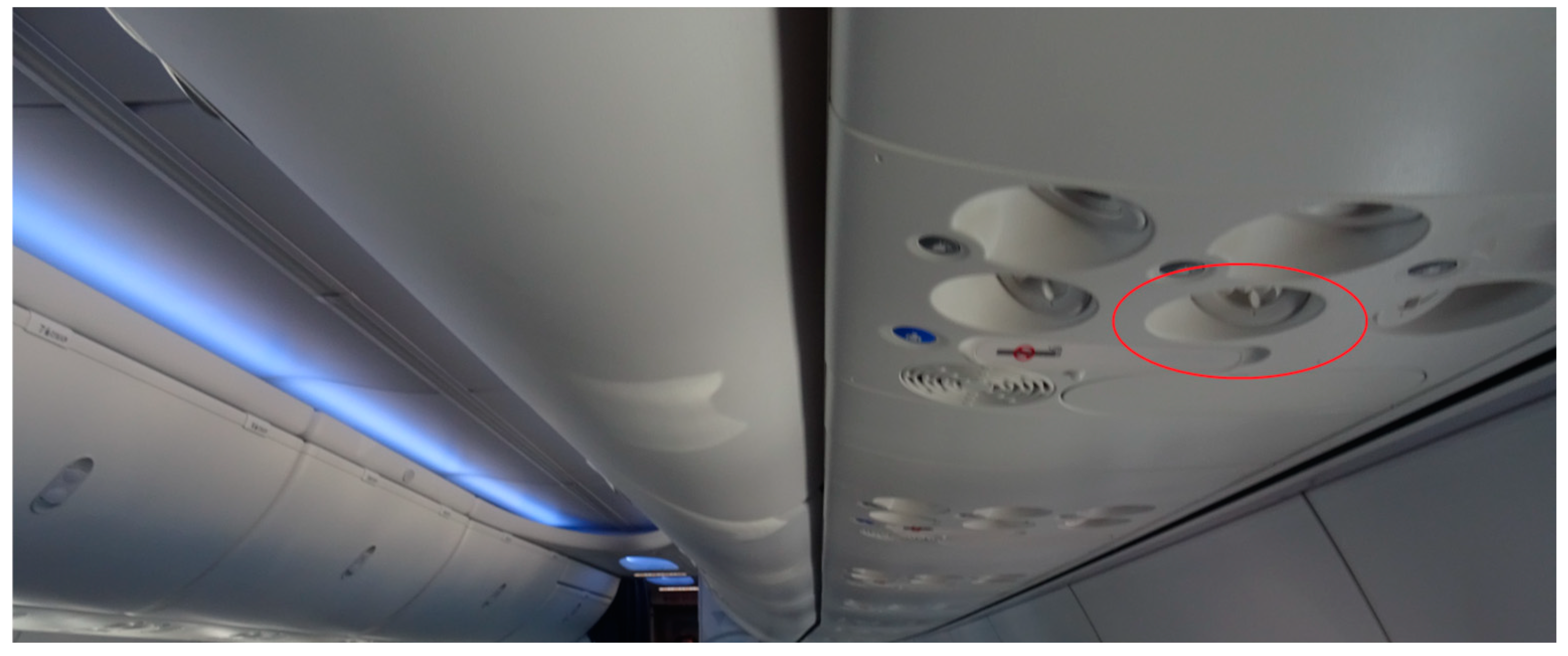
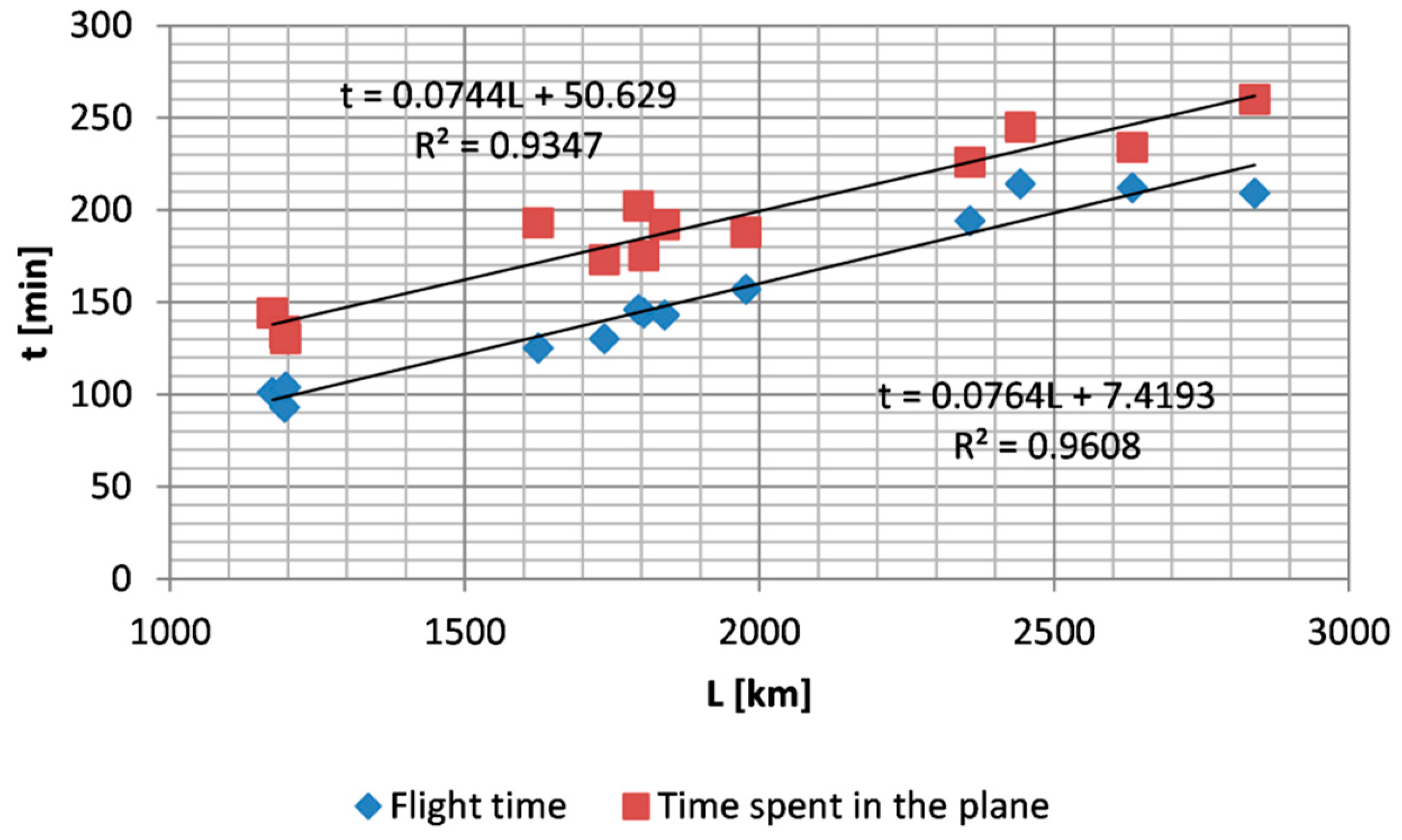

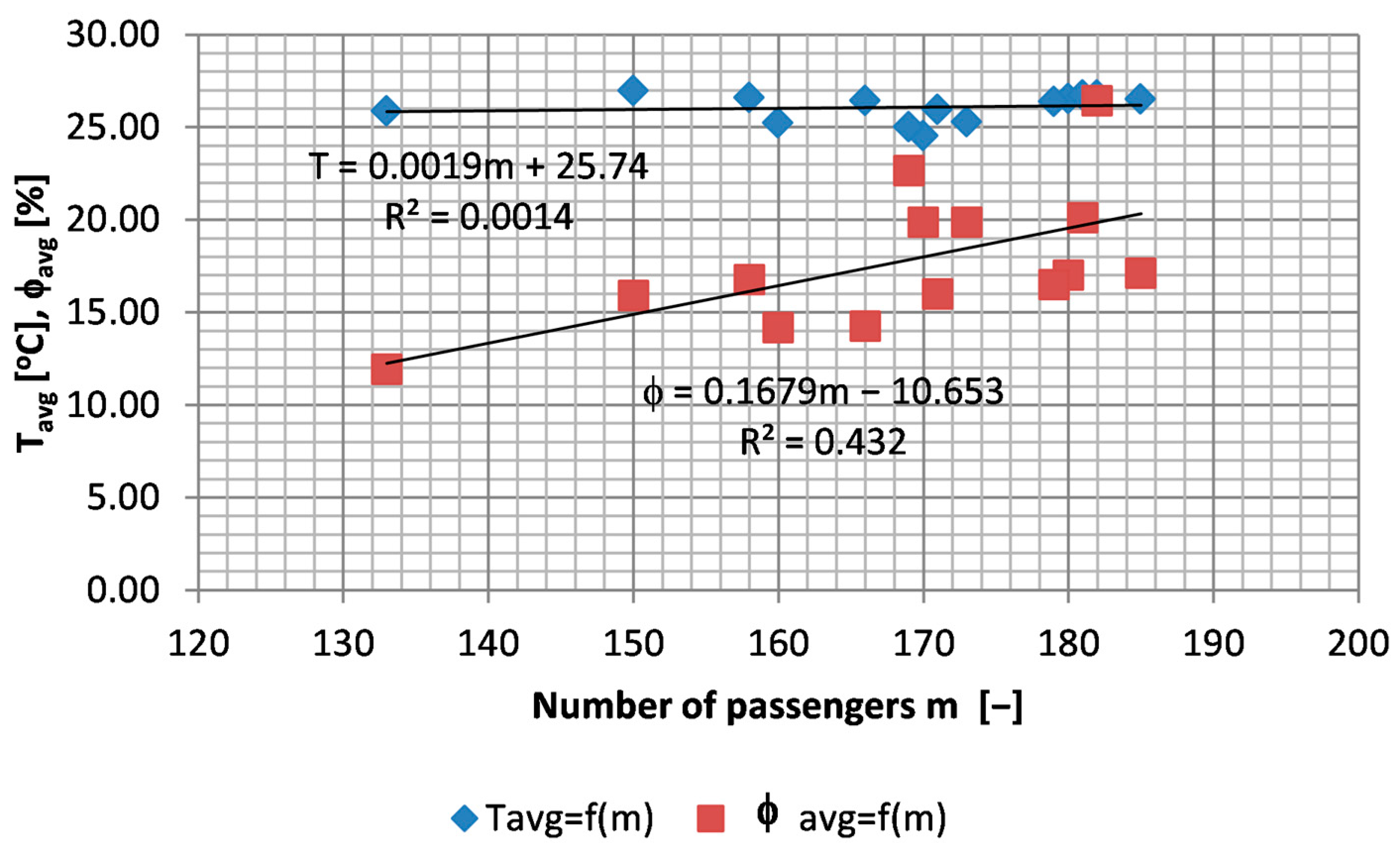

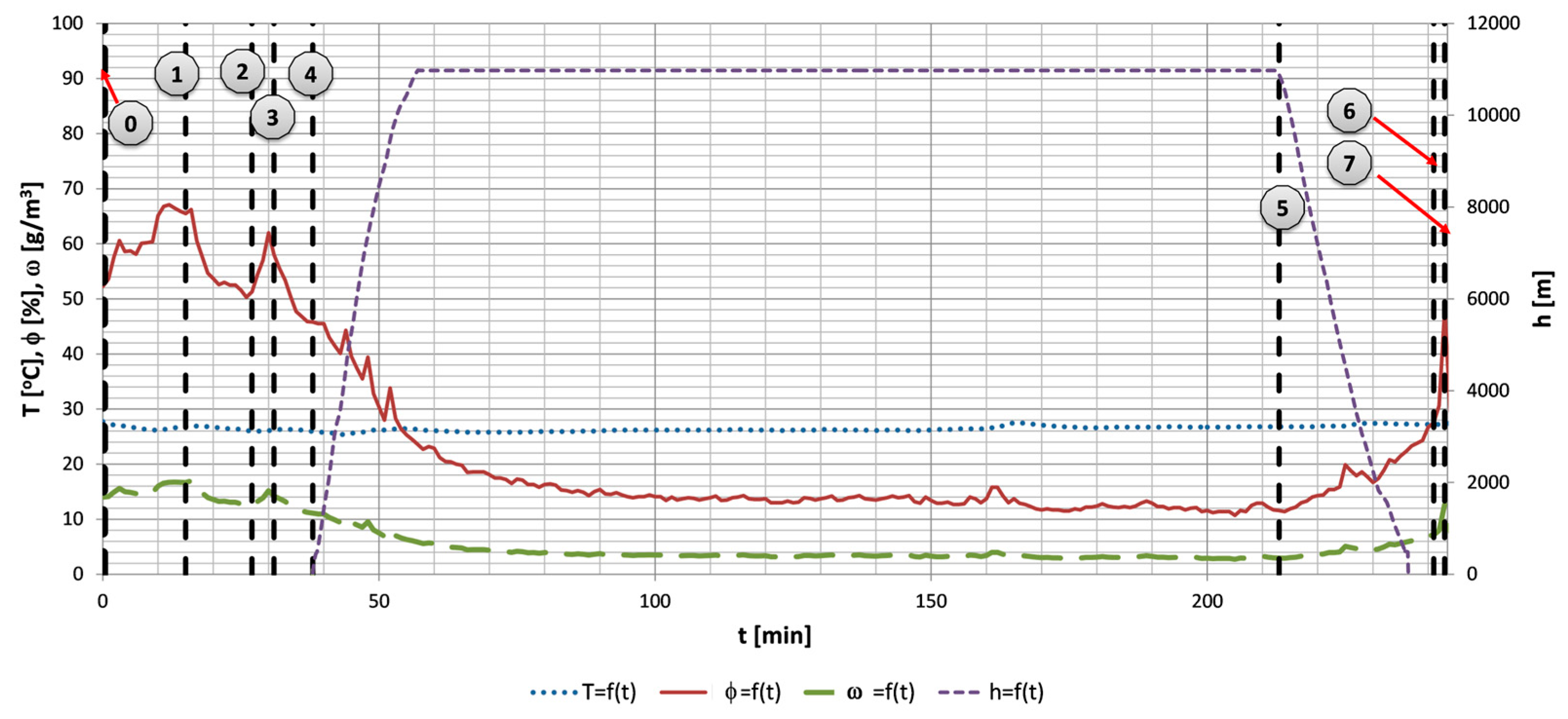
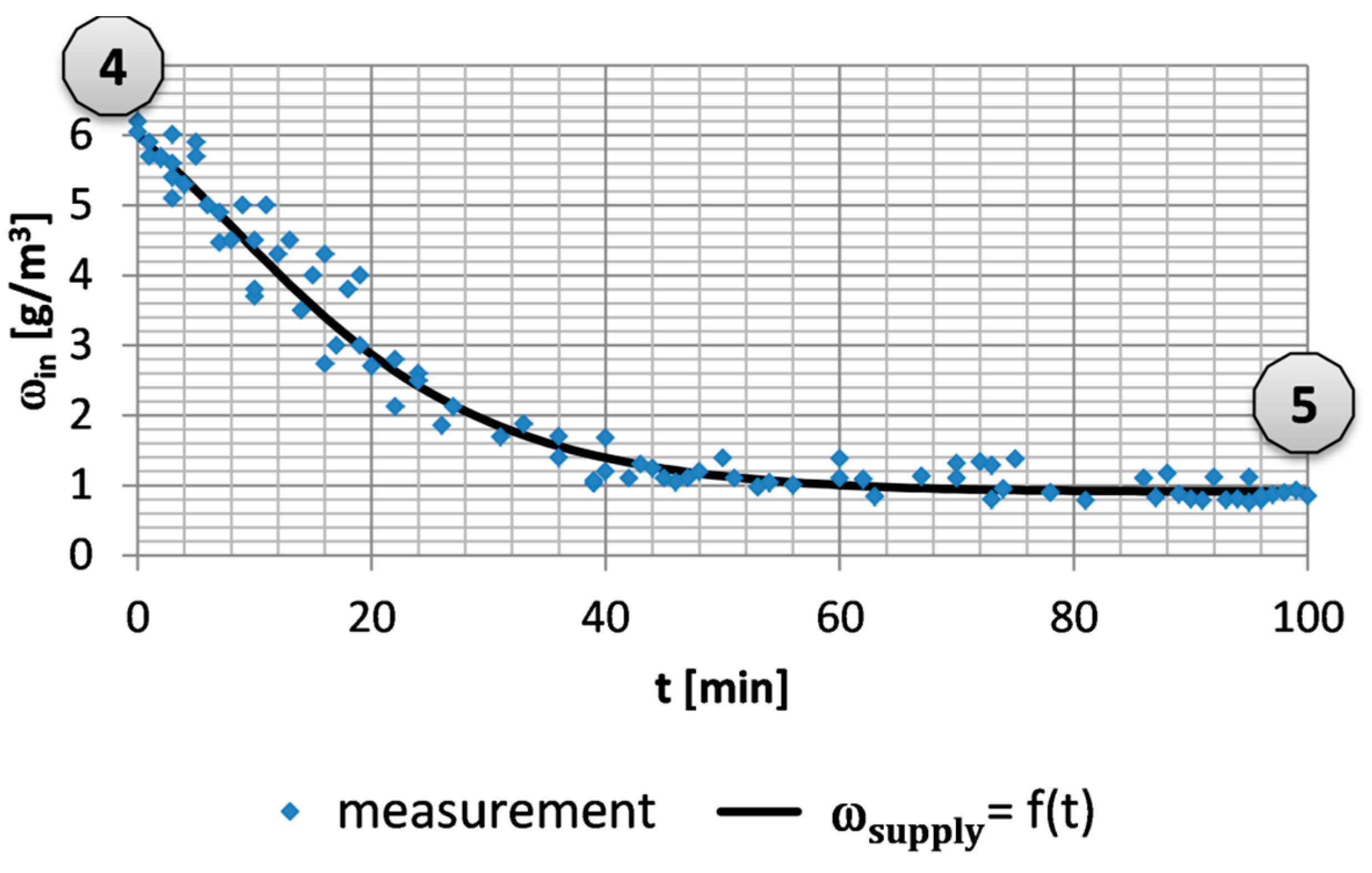



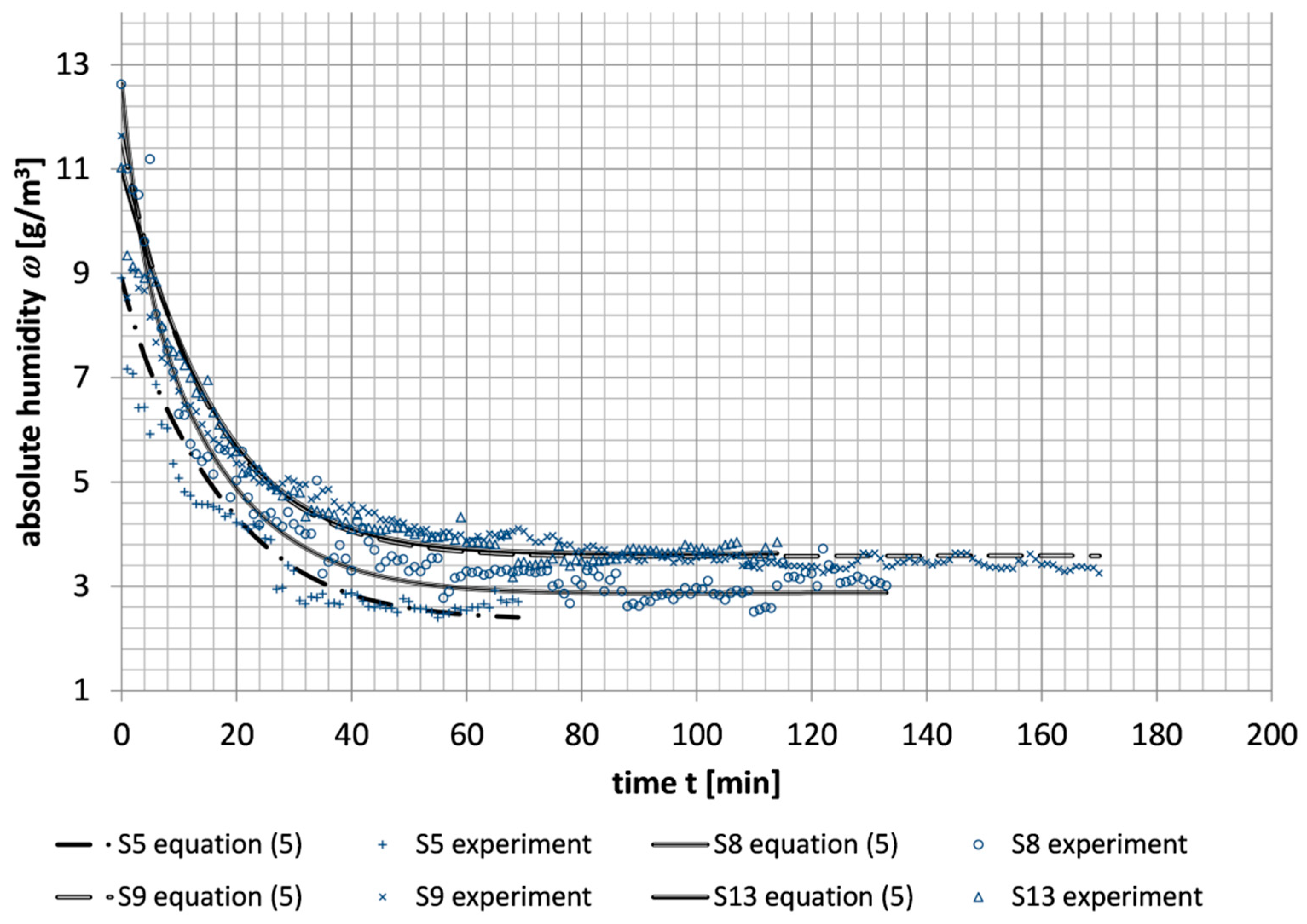
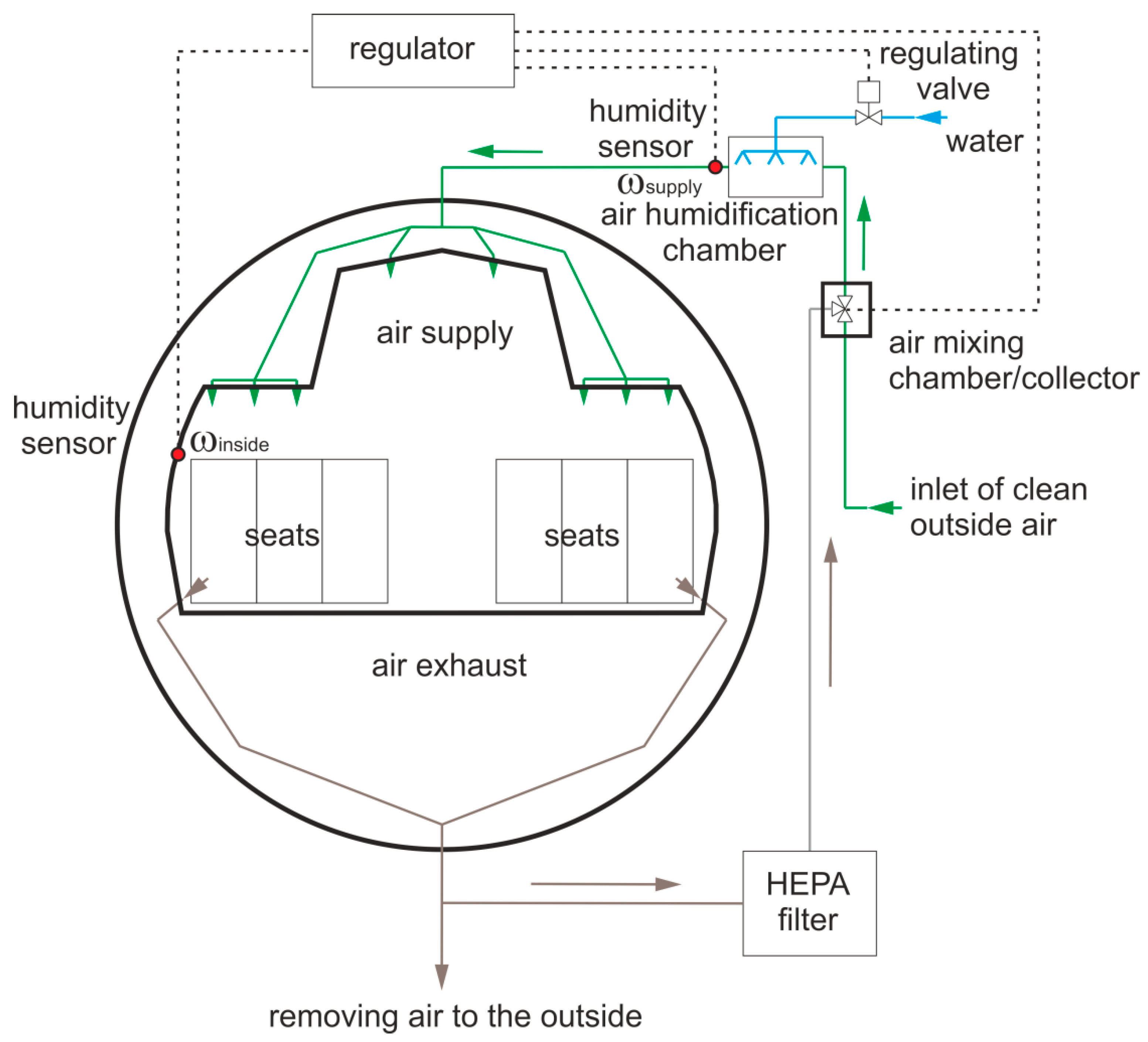
| No. Series | Air Route | Plane Model | Date | Route Length | Time Spent in the Plane | Time Spent in the Plane Before the Flight | Flight Time | Time Spent in the Plane After Landing | Number of Passengers m |
|---|---|---|---|---|---|---|---|---|---|
| - | - | - | - | km | min | min | min | min | - |
| S1 | Modlin–Málaga | Boeing 737-800 | Nov. 2021 | 2633 | 234 | 10 | 212 | 12 | 180 |
| S2 | Malaga–Modlin | Boeing 737-800 | Nov. 2021 | 2840 | 260 | 40 | 209 | 11 | 171 |
| S3 | Modlin–Catania | Boeing 737-800 | Mar. 2022 | 1804 | 175 | 25 | 144 | 6 | 166 |
| S4 | Catania–Modlin | Boeing 737-800 | Mar. 2022 | 1795 | 202 | 39 | 146 | 17 | 150 |
| S5 | Modlin–Bologna | Boeing 737-800 | May 2022 | 1195 | 133 | 30 | 93 | 10 | 160 |
| S6 | Bologna–Modlin | Boeing 737-800 | May 2022 | 1174 | 144 | 34 | 101 | 9 | 181 |
| S7 | Warsaw–Kos | Boeing 737-800 | Jul. 2022 | 1978 | 188 | 28 | 157 | 3 | 158 |
| S8 | Kos–Warsaw | Boeing 737-800 | Aug. 2022 | 1839 | 192 | 41 | 143 | 8 | 170 |
| S9 | Modlin–Alicante | Boeing 737-800 | Nov. 2022 | 2358 | 226 | 26 | 194 | 6 | 185 |
| S10 | Alicante–Modlin | Boeing 737-800 | Nov. 2022 | 2443 | 245 | 27 | 214 | 4 | 179 |
| S11 | Modlin–Bolonia | Boeing 737-800 | Dec. 2022 | 1195 | 134 | 26 | 103 | 5 | 133 |
| S12 | Bolonia–Modlin | Boeing 737-800 | Dec. 2022 | 1196 | 130 | 19 | 104 | 7 | 169 |
| S13 | Warsaw–Zahyntos | Boeing 737 MAX 8 | Aug. 2022 | 1737 | 173 | 38 | 130 | 5 | 173 |
| S14 | Zahyntos–Warsaw | Boeing 737 MAX 8 | Aug. 2022 | 1625 | 193 | 49 | 125 | 19 | 182 |
| No. Series | Average Temperature in Airplane Cabin | Average Relative Humidity in Airplane Cabin | ||||||
|---|---|---|---|---|---|---|---|---|
| Before the Plane Takes Off | In Flight | After the Plane Lands | During the Entire Stay in the Aircraft Cabin | Before the Plane Takes Off | In Flight | After the Plane Lands | During the Entire Stay in the Aircraft Cabin | |
| Tavg | Tavg | Tavg | Tavg | ϕavg | ϕavg | ϕavg | ϕavg | |
| - | °C | °C | °C | °C | % | % | % | % |
| S1 | 23.10 | 26.55 | 26.10 | 26.47 | 49.60 | 17.01 | 30.70 | 18.94 |
| S2 | 27.54 | 25.96 | 26.10 | 25.95 | 51.14 | 15.98 | 30.42 | 23.57 |
| S3 | 24.73 | 26.43 | 26.10 | 26.27 | 33.19 | 14.24 | 28.67 | 17.42 |
| S4 | 27.97 | 26.98 | 26.10 | 27.28 | 42.61 | 15.90 | 26.34 | 21.91 |
| S5 | 27.67 | 25.23 | 26.20 | 25.83 | 31.29 | 14.17 | 28.29 | 18.68 |
| S6 | 30.36 | 26.73 | 26.20 | 27.70 | 43.52 | 20.11 | 33.04 | 26.40 |
| S7 | 25.48 | 26.60 | 26.60 | 26.41 | 43.73 | 16.74 | 32.70 | 21.00 |
| S8 | 26.97 | 24.55 | 26.40 | 25.09 | 59.37 | 19.85 | 34.93 | 28.87 |
| S9 | 22.95 | 26.53 | 26.50 | 26.17 | 22.95 | 17.11 | 34.52 | 22.75 |
| S10 | 26.51 | 26.40 | 26.50 | 26.44 | 26.51 | 16.50 | 30.81 | 23.16 |
| S11 | 24.67 | 25.89 | 26.60 | 25.68 | 24.67 | 11.90 | 22.57 | 16.49 |
| S12 | 25.37 | 25.03 | 26.60 | 25.28 | 25.37 | 22.63 | 30.00 | 27.35 |
| S13 | 26.21 | 25.29 | 26.50 | 25.52 | 26.21 | 19.85 | 29.82 | 25.63 |
| S14 | 25.96 | 26.75 | 26.60 | 26.41 | 25.96 | 26.41 | 37.51 | 26.41 |
| Average | values | |||||||
| - | 26.11 | 26.07 | 26.36 | 26.18 | 36.15 | 17.74 | 30.74 | 22.76 |
| No. Series | Measurement Period | |||
|---|---|---|---|---|
| Before the Plane Takes Off | In Flight | After the Plane Lands | During the Entire Stay in the Aircraft Cabin | |
| S1 | Intermediate | Intermediate | Good | Intermediate |
| S2 | Bad | Intermediate | Good | Intermediate |
| S3 | Good | Intermediate | Intermediate | Intermediate |
| S4 | Intermediate | Intermediate | Intermediate | Bad |
| S5 | Intermediate | Intermediate | Intermediate | Intermediate |
| S6 | Intermediate | Intermediate | Good | Bad |
| S7 | Good | Intermediate | Good | Intermediate |
| S8 | Intermediate | Intermediate | Good | Intermediate |
| S9 | Bad | Intermediate | Good | Intermediate |
| S10 | Intermediate | Intermediate | Good | Intermediate |
| S11 | Intermediate | Intermediate | Intermediate | Intermediate |
| S12 | Intermediate | Intermediate | Intermediate | Intermediate |
| S13 | Intermediate | Intermediate | Intermediate | Intermediate |
| S14 | Intermediate | Intermediate | Good | Intermediate |
| Average values | ||||
| Good | Intermediate | Good | Intermediate | |
| a | b | c | d | e | f | g |
|---|---|---|---|---|---|---|
| 6 | −0.13 | 0.002 | 1 | 0.002 | 0.001 | 0.000003 |
| No. Series | The Initial Value of Absolute Humidity at the Moment of Take-Off of the Plane | Number of Air Changes | Relative Error of Absolute Humidity According to (6) |
|---|---|---|---|
| ωt = 0 | n | δωinside | |
| - | g/m3 | L/h | % |
| S1 | 9.84 | 12 | 6.67 |
| S2 | 11.48 | 13 | 7.86 |
| S3 | 7.62 | 17 | 7.38 |
| S4 | 9.85 | 11 | 7.48 |
| S5 | 8.91 | 19 | 7.95 |
| S6 | 12.75 | 12 | 5.75 |
| S7 | 9.28 | 15 | 7.12 |
| S8 | 12.62 | 15 | 7.57 |
| S9 | 11.64 | 12 | 6.15 |
| S10 | 11.09 | 13 | 5.84 |
| S11 | 7.50 | 15 | 6.20 |
| S12 | 9.14 | 10 | 2.63 |
| S13 | 11.03 | 11 | 3.83 |
| S14 | 8.71 | 11 | 8.39 |
Disclaimer/Publisher’s Note: The statements, opinions and data contained in all publications are solely those of the individual author(s) and contributor(s) and not of MDPI and/or the editor(s). MDPI and/or the editor(s) disclaim responsibility for any injury to people or property resulting from any ideas, methods, instructions or products referred to in the content. |
© 2025 by the authors. Licensee MDPI, Basel, Switzerland. This article is an open access article distributed under the terms and conditions of the Creative Commons Attribution (CC BY) license (https://creativecommons.org/licenses/by/4.0/).
Share and Cite
Teleszewski, T.J.; Gładyszewska-Fiedoruk, K. Development of a Simplified One-Dimensional Model of Humidity in the Cabin of a Passenger Aircraft Based on an Experiment. Atmosphere 2025, 16, 280. https://doi.org/10.3390/atmos16030280
Teleszewski TJ, Gładyszewska-Fiedoruk K. Development of a Simplified One-Dimensional Model of Humidity in the Cabin of a Passenger Aircraft Based on an Experiment. Atmosphere. 2025; 16(3):280. https://doi.org/10.3390/atmos16030280
Chicago/Turabian StyleTeleszewski, Tomasz Janusz, and Katarzyna Gładyszewska-Fiedoruk. 2025. "Development of a Simplified One-Dimensional Model of Humidity in the Cabin of a Passenger Aircraft Based on an Experiment" Atmosphere 16, no. 3: 280. https://doi.org/10.3390/atmos16030280
APA StyleTeleszewski, T. J., & Gładyszewska-Fiedoruk, K. (2025). Development of a Simplified One-Dimensional Model of Humidity in the Cabin of a Passenger Aircraft Based on an Experiment. Atmosphere, 16(3), 280. https://doi.org/10.3390/atmos16030280











